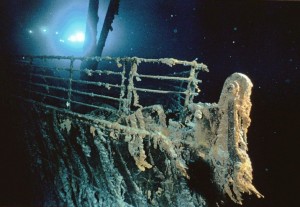Think of the opening scenes of the classic 1997 movie Titanic. Better yet, watch the first minute of the trailer and note the portrayal of the researchers.
As the happy people of 1912 wave goodbye, the present day “archaeologists”—who are really just adventurers—sink to the depths of the underwater site where the Titanic rests. While this movie wildly promotes the stereotypes about archaeology, it did get some things right. The point of archaeology in general is to understand more about the past and to learn the stories of individuals without the bias of historians. If we can understand the life of the individual, we have a better grasp on what the average life was like for a certain group of people.
This movie is incredibly well known. If this portrayal is so influential as to how people think about underwater archaeology, shouldn’t there be more accuracy in the representation of such an important method in understanding our past? In comparison to the presentation we heard by Joseph Zarzynski on the underwater archaeology of the Land Tortoise colonial warship in Lake George, NY, Hollywood and real-life archaeologists have two completely different ideas of what underwater archaeology is.
In the movie, there is one goal for the researchers on the boat: finding the necklace. Just like every representation of archaeology in the media, the science is skewed to be more attractive. The greedy archaeologist has no greater ambition than to find the incredibly rare diamond. The viewers will now think archaeology is about discovering lost ships and finding hidden treasure that has been lost for years. In reality, archaeologists rarely find anything big. Archaeology is most useful for the smaller parts of life. An archaeologist could spend hours just surveying the land and figure out what the past uses for that area were. While this seems insignificant, it could help a farmer better use the land for his agriculture or tell a town about the schoolhouse their ancestors all attended. Archaeology can improve the lives of people today.
When archaeologists first started looking at the Land Tortoise, they had a procedure to follow. Since they would have to dive down 100 feet to do anything and they only had around 16 minutes for each dive, they had to plan out what was to be accomplished. There were no impulsive dives like the ones to search for the necklace in Titanic. Zarzynski and the other archaeologist also practiced minimally invasive archaeology. This means they weren’t tearing the boat apart in order to learn more about it, but preserving it for others to observe and learn from. They didn’t move any of the planks and certainly didn’t break into the boat to find an artifact they weren’t even sure was there. They spent most of their time underwater mapping out the Land Tortoise and taking photos to put together a visual of what the ship looked like when it was initially sunk. The real treasure of this archaeology is gaining an understanding of how the past of this boat relates to our present and sharing that with the public.
Works Cited:
Image Link: http://www.astrosurf.com/luxorion/qsl-ham-history-titanic.htm
Video Link: http://www.youtube.com/watch?v=xtVyu-A3vkY
“New York.” Archaeology Program. National Park Service, n.d. Web. 29 Sept. 2013. <http://www.astrosurf.com/luxorion/qsl-ham-history-titanic.htm>.


The archaeology of the Titanic presented a unique challenge to researchers, it seems, by virtue of its notoriety; just as the “archaeologist” portrayed in the Titanic trailer searched obsessively for Rose’s diamond, the artifacts of the shipwreck is certainly of great interest to many treasure hunters, for sale or just to have a souvenir of the famous wreck. Researcher James P. Delgado says that, upon examination of the wreckage in early 2000, he saw “scoop marks that show where selected pieces have been plucked from clusters of artifacts—no grids, no scientific sampling—simply for their display or monetary value. What is happening here…is not archaeology…” In an attempt to counteract the sometimes-questionable work at the Titanic, Delgado and his colleagues have begun “the task of identifying features, artifacts, and their contexts,” as well as working to make a comprehensive map of the ship from the ruins.
If you’d like to read more about Delgado’s work, please refer to this article: http://archive.archaeology.org/1205/features/titanic_shipwreck_jean_charcot_site_map.html
I didn’t realize there was such an industry behind the Titanic and its souvenirs. Just one search for “Titanic memorabilia” led to this incredibly recent article about a violin from the ship: http://www.usatoday.com/story/news/world/2013/10/18/violin-that-played-as-titanic-sank-to-go-on-sale/3007245/.
This violin, believed to be from one of the bandmasters named Wallace Hartley who died on the Titanic, was found with Hartley’s body and was taken weeks after the wreck happened. Archaeologists never had a chance to record this finding and never had a chance at collecting all of the data and artifacts connected to the Titanic. There are too many people interested in owning a piece of history. Even with Delgado’s exquisite work and aim to put the archaeology of the ship on track, the Titanic can never be put all the way back together again. So many things have been taken from the wreck and so many things have been lost, but the same can really be seen in every site. This especially affects the Titanic because of its fame, but even in the case of old factory buildings and Indigenous burial sites, people take and change what’s there. Archaeology is all about solving the puzzle of what was there to begin with.